Evaluation of Crack Formation in Heat Pipe-Welded Joints
Abstract
1. Introduction
2. Materials and Methods
3. Results
3.1. Visual Inspection and Thickness Measurement
3.2. Mechanical Properties
3.3. Microstructural Analysis
3.4. Stress Analysis Simulation
3.5. Electrochemical Properties
3.6. Corrosion Failure Mechanisms
4. Conclusions
- Microstructural analysis revealed that coarse-grained HAZ (CGHAZ) contained coarse grains and exhibited the highest hardness (>300 HV), indicating increased brittleness. KAM analysis showed a high density of geometrically necessary dislocations (GNDs), leading to localized strain and greater susceptibility to crack initiation.
- Finite element analysis confirmed that CGHAZ experienced the highest stress concentration, with peak localized stresses exceeding 475 MPa. This stress level surpassed the yield strength of the base metal (349 MPa) and approached that of the weld metal (384 MPa), indicating that CGHAZ was subjected to severe stress conditions. Thermal expansion and residual welding stresses created a localized stress gradient at the weld toe and CGHAZ boundary, further intensifying crack susceptibility.
- Electrochemical tests confirmed that the HAZ exhibited low open circuit potential (OCP), acting as the anodic region and promoting localized corrosion. The presence of micro-pitting and oxide penetration along the fracture surface further indicates that electrochemical degradation, in combination with operating and residual stress, contributed to the initiation and propagation of stress corrosion cracking (SCC).
Author Contributions
Funding
Institutional Review Board Statement
Informed Consent Statement
Data Availability Statement
Acknowledgments
Conflicts of Interest
References
- McCafferty, E. Introduction to Corrosion Science; Springer: New York, NY, USA, 2010; pp. 13–31. [Google Scholar]
- Song, M.J.; Choi, G.; Chae, H.; Kim, W.C.; Kim, H.; Kim, J.G.; Lee, S.Y. Corrosion failure analysis of flow plate in plate heat exchanger. Corros. Sci. Technol. 2021, 20, 204–209. [Google Scholar]
- Kim, H.T.; Kil, S.C.; Hwang, W.S.; Cho, W.S. Investigation on the corrosion behaviour of weld structure. Corros. Sci. Technol. 2007, 6, 33–35. [Google Scholar]
- Song, M.J.; Choi, G.; Kim, W.C.; Lee, S.Y. Cause of Corrosion and Evaluation of Material Corrosion Resistance on Underground Heat Transport Facilities Connected to Manhole. J. Korean Soc. Heat Treat. 2022, 35, 193–202. [Google Scholar]
- Cho, J.; Chae, H.; Kim, H.; Kim, J.G.; Kim, W.C.; Lee, S.Y. Failure Analysis of Stress Reliever in Heat-Transport Pipe of District Heating System. Corros. Sci. Technol. 2022, 21, 243–249. [Google Scholar]
- Lins, V.F.C.; Guimaraes, E.M. Failure of a heat exchanger generated by an excess of SO2 and H2S in the sulfur recovery unit of a petroleum refinery. J. Loss Prev. Process Ind. 2007, 20, 91–97. [Google Scholar] [CrossRef]
- Tang, Z.; Wang, Z.; Lu, Y.; Sun, P. Cause analysis and preventive measures of pipeline corrosion and leakage accident in alkylation unit. Eng. Fail. Anal. 2021, 128, 105623. [Google Scholar] [CrossRef]
- Song, M.J.; Kim, W.C.; Kim, H.; Kim, J.G.; Lee, S.Y. Corrosion Failure Analysis of a Biogas Pipe. J. Korean Soc. Heat Treat. 2023, 36, 153–160. [Google Scholar]
- Kim, S.H.; Lee, S.M.; Lee, J.H. A two-phase flow accelerated corrosion study on water wall tube of coal-fired boiler according to flexible operation. Corros. Sci. Technol. 2024, 23, 246–254. [Google Scholar]
- Bain, D.I.; Christophersen, D.L. Some common mechanisms leading to failures in heat recovery steam generators. In Proceedings of the NACE CORROSION Conference; NACE: Pennsylvania, PA, USA, 2003; Paper No. 03489. [Google Scholar]
- Dooley, B.; Anderson, B. HRSG assessments identify trends in cycle chemistry thermal transient performance. Power Plant Chem. 2009, 11, 115–130. [Google Scholar]
- Li, Q.; Yao, Q.; Sun, L.; Ma, H.; Zhang, C.; Wang, N. Effect of micro-galvanic corrosion on corrosion fatigue cracking of the weld joint of high strength bridge steel. Int. J. Fatigue 2023, 170, 107568. [Google Scholar] [CrossRef]
- Huang, Y.; Zhang, J.; Xuan, F.Z.; Ma, Y. Modeling and prediction of galvanic corrosion for an overlaying welded structure. J. Mater. Eng. Perform. 2024, 33, 6111–6123. [Google Scholar] [CrossRef]
- Lin, M.B.; Gao, K.; Wang, C.J.; Volinsky, A.A. Failure analysis of the oil transport spiral welded pipe. Eng. Fail. Anal. 2012, 25, 169–174. [Google Scholar] [CrossRef]
- Xia, Z.; Huang, Y.; Zhong, J.; Guan, K. Cracking failure analysis on a high-frequency electric resistance welding pipe in buried fire water pipeline. Eng. Fail. Anal. 2023, 146, 107072. [Google Scholar] [CrossRef]
- Ul-Hamid, A.; Tawancy, H.M.; Abbas, N.M. Failure of weld joints between carbon steel pipe and 304 stainless steel elbows. Eng. Fail. Anal. 2005, 12, 181–191. [Google Scholar] [CrossRef]
- Shirinzadeh-Dastgiri, M.; Mohammadi, J.; Behnamian, Y.; Eghlimi, A.; Mostafaei, A. Metallurgical investigations and corrosion behavior of failed weld joint in AISI 1518 low carbon steel pipeline. Eng. Fail. Anal. 2015, 53, 78–96. [Google Scholar] [CrossRef]
- Gadala, M.; Gadala, I.; Gomaa, A. Failure assessment of seam-welded pipe under fatigue and thermal loading. Eng. Fail. Anal. 2025, 167, 108934. [Google Scholar] [CrossRef]
- Li, Y.; Hu, T.; Li, Q.; Wu, Y.; Wang, L.; You, Y.; Wang, B. Evaluation of the stress corrosion crack growth behaviour of high-strength marine steel based on model of crack tip mechano-electrochemical effect. J. Mater. Sci. Technol. 2024, 190, 93–105. [Google Scholar] [CrossRef]
- Winzer, N.; Atrens, A.; Song, G.; Ghali, E.; Dietzel, W.; Kainer, K.U.; Blawert, C. A critical review of the stress corrosion cracking (SCC) of magnesium alloys. Adv. Eng. Mater. 2005, 7, 659–693. [Google Scholar] [CrossRef]
- Saravanan, N.; Karamched, P.S.; Liu, J.; Rainasse, C.; Scenini, F.; Lozano-Perez, S. Using local GND density to study SCC initiation. Ultramicroscopy 2020, 217, 113054. [Google Scholar] [CrossRef]
- Meisnar, M.; Vilalta-Clemente, A.; Moody, M.; Arioka, K.; Lozano-Perez, S. A mechanistic study of the temperature dependence of the stress corrosion crack growth rate in SUS316 stainless steels exposed to PWR primary water. Acta Mater. 2016, 114, 15–24. [Google Scholar] [CrossRef]
- Kim, Y.S.; Nam, H.S.; Kwon, Y.H.; Kim, S.W.; Kim, H.P.; Chang, H.Y. Relationship between the initiation and propagation of SCC and the electrochemical noise of Alloy 600 for the steam generator tubing of nuclear power plants. Corros. Sci. Technol. 2010, 9, 57–66. [Google Scholar]
- Borchert, M.; Mori, G.; Bischof, M.; Tomandl, A. Accelerated SCC testing of stainless steels according to corrosion resistance classes. Corros. Sci. Technol. 2015, 14, 280–287. [Google Scholar] [CrossRef]
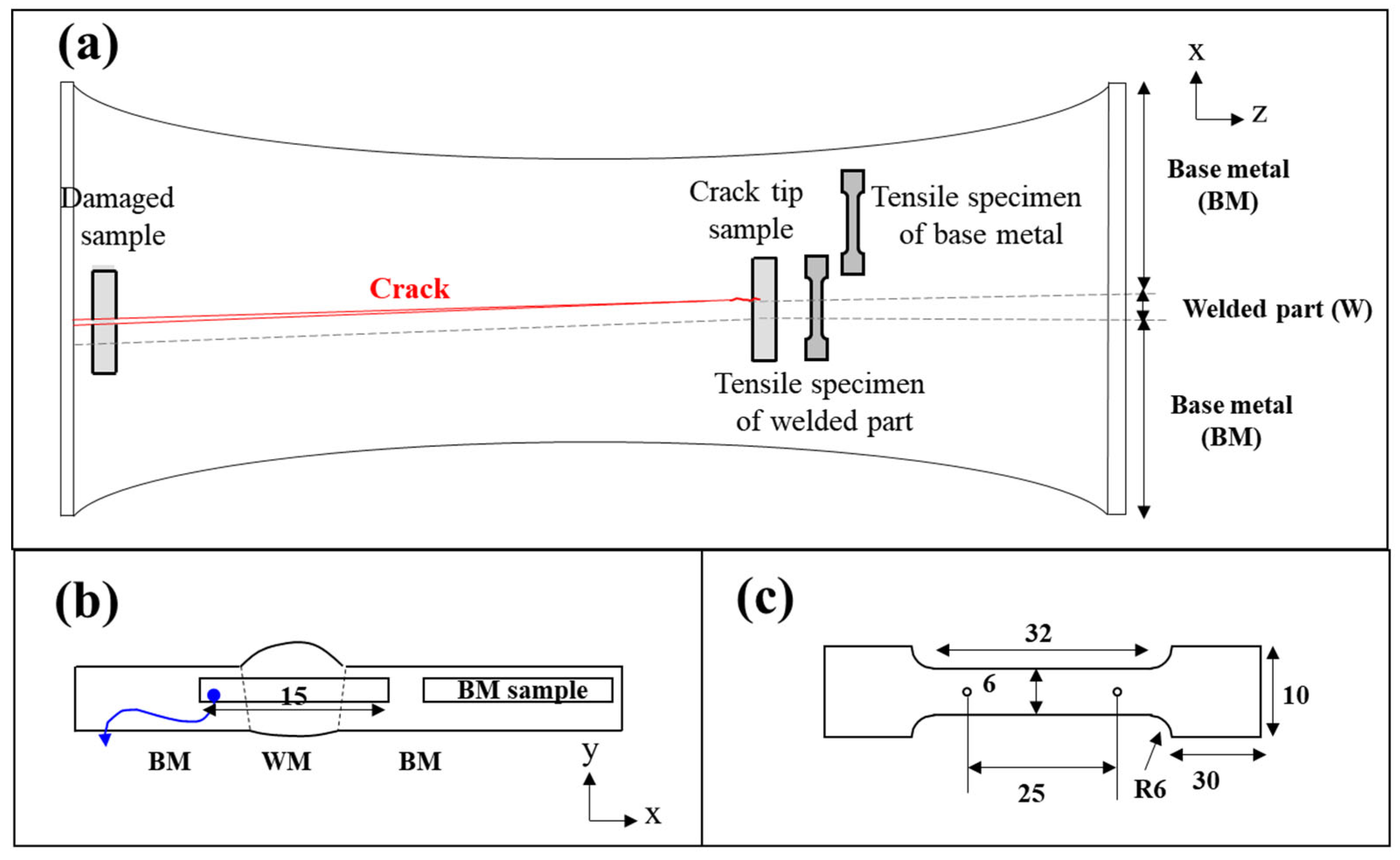
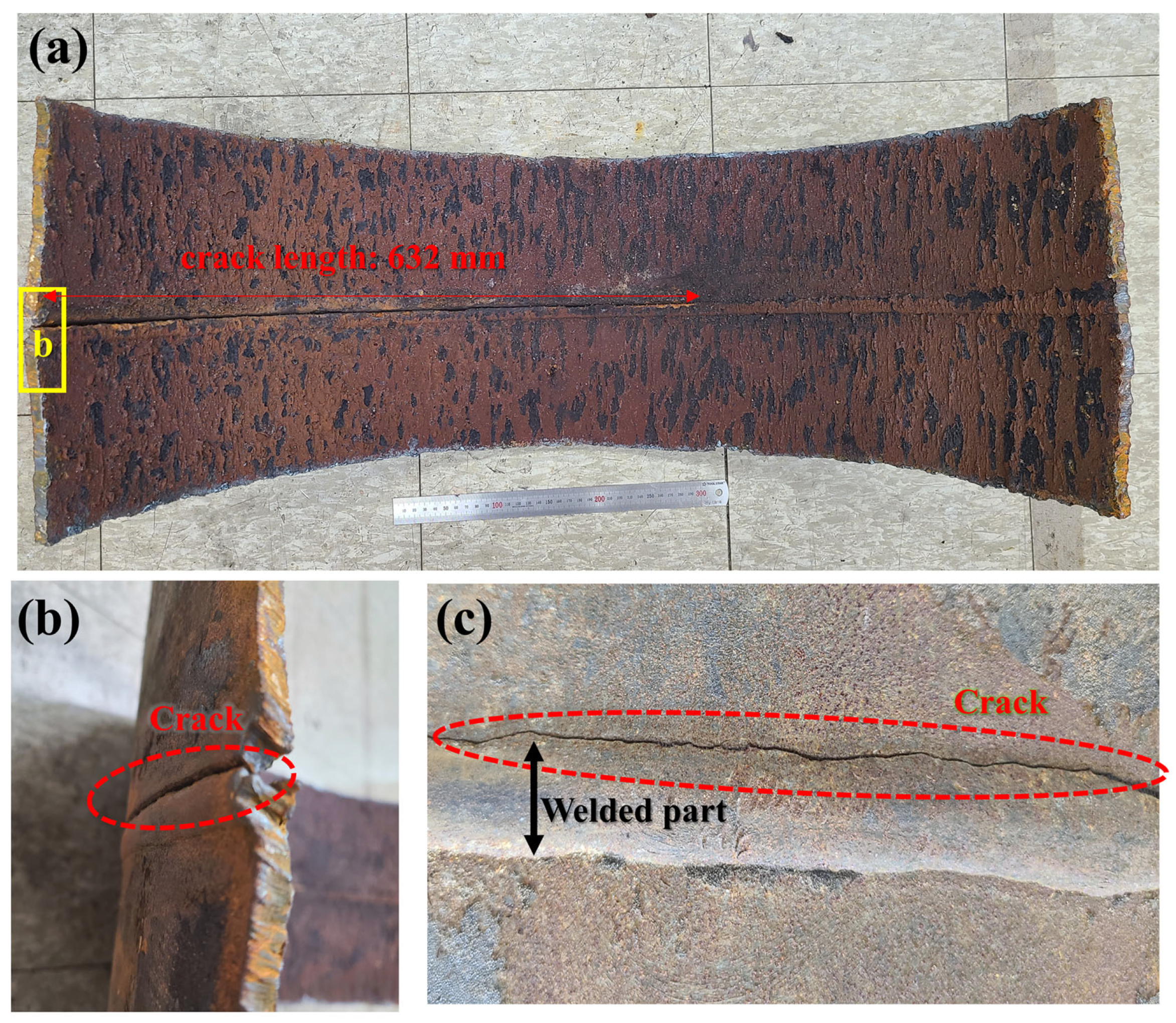
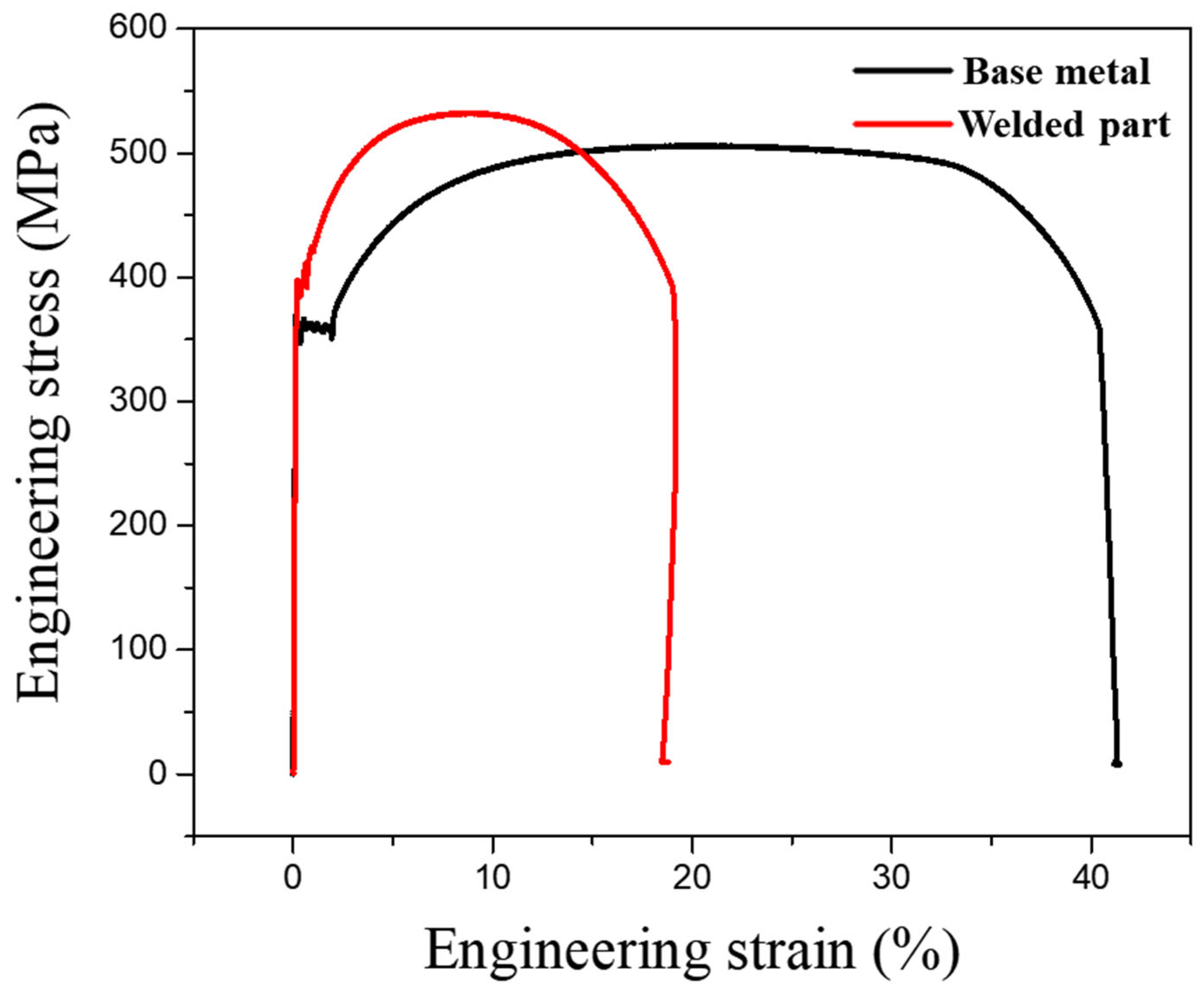

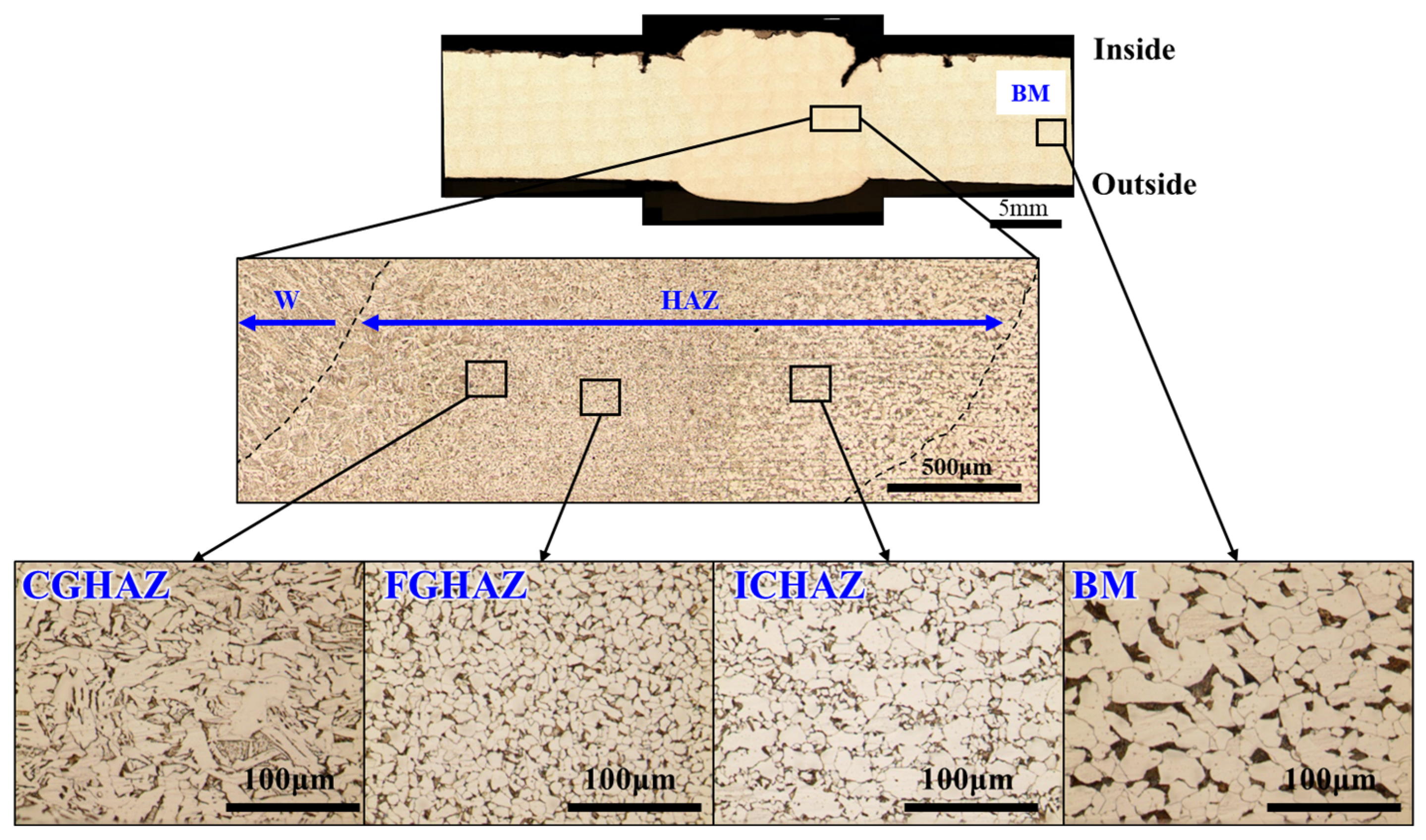
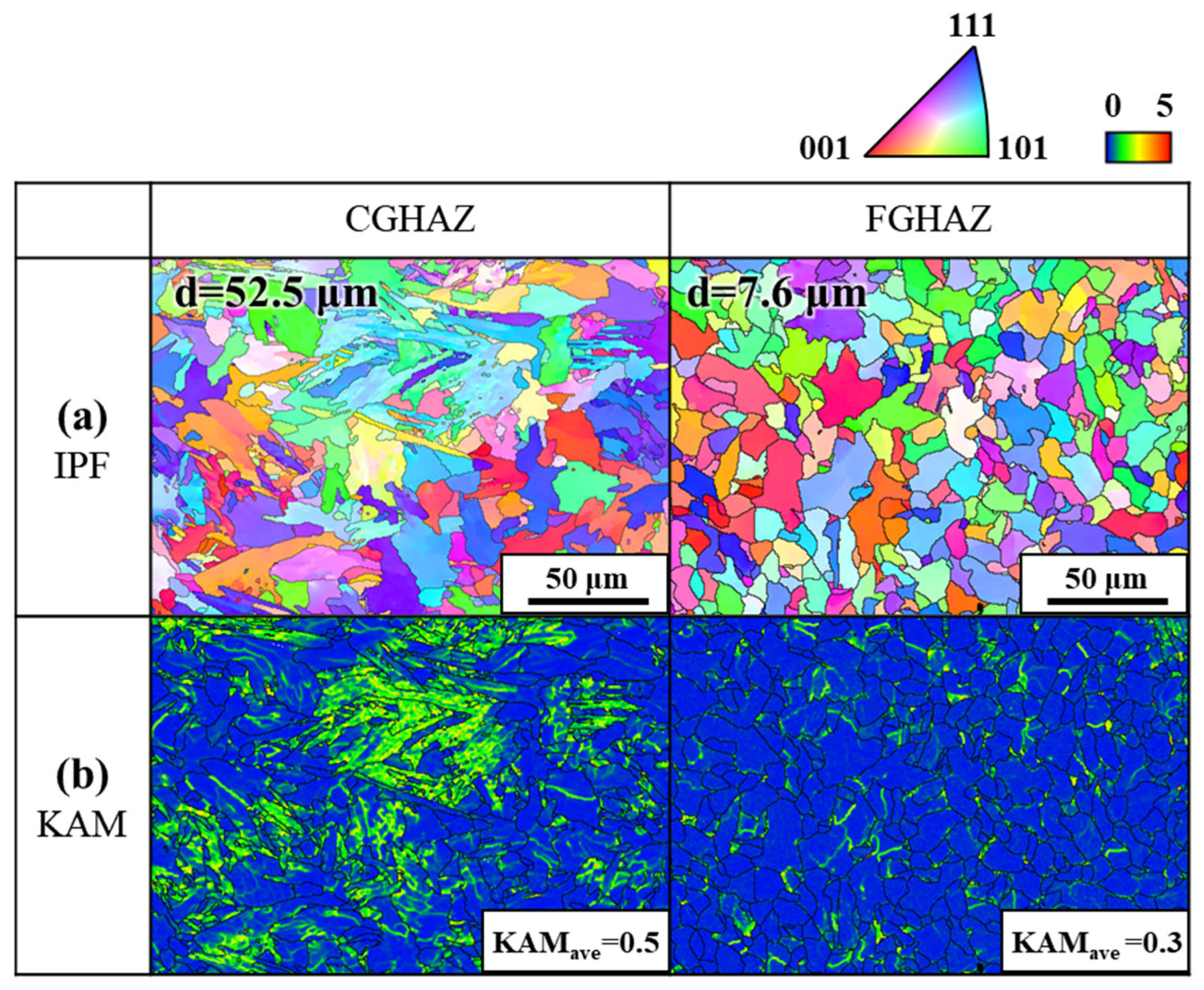
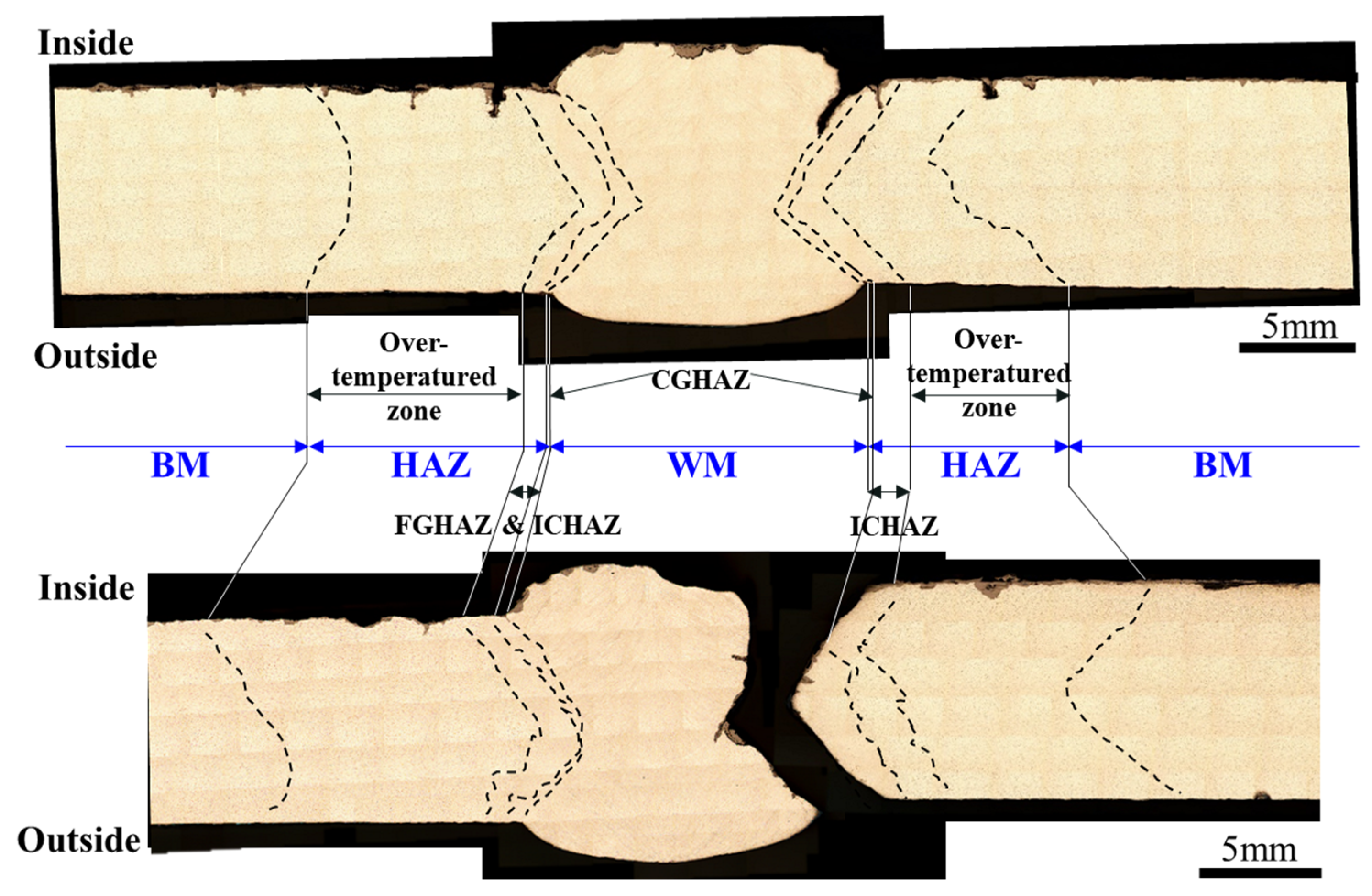

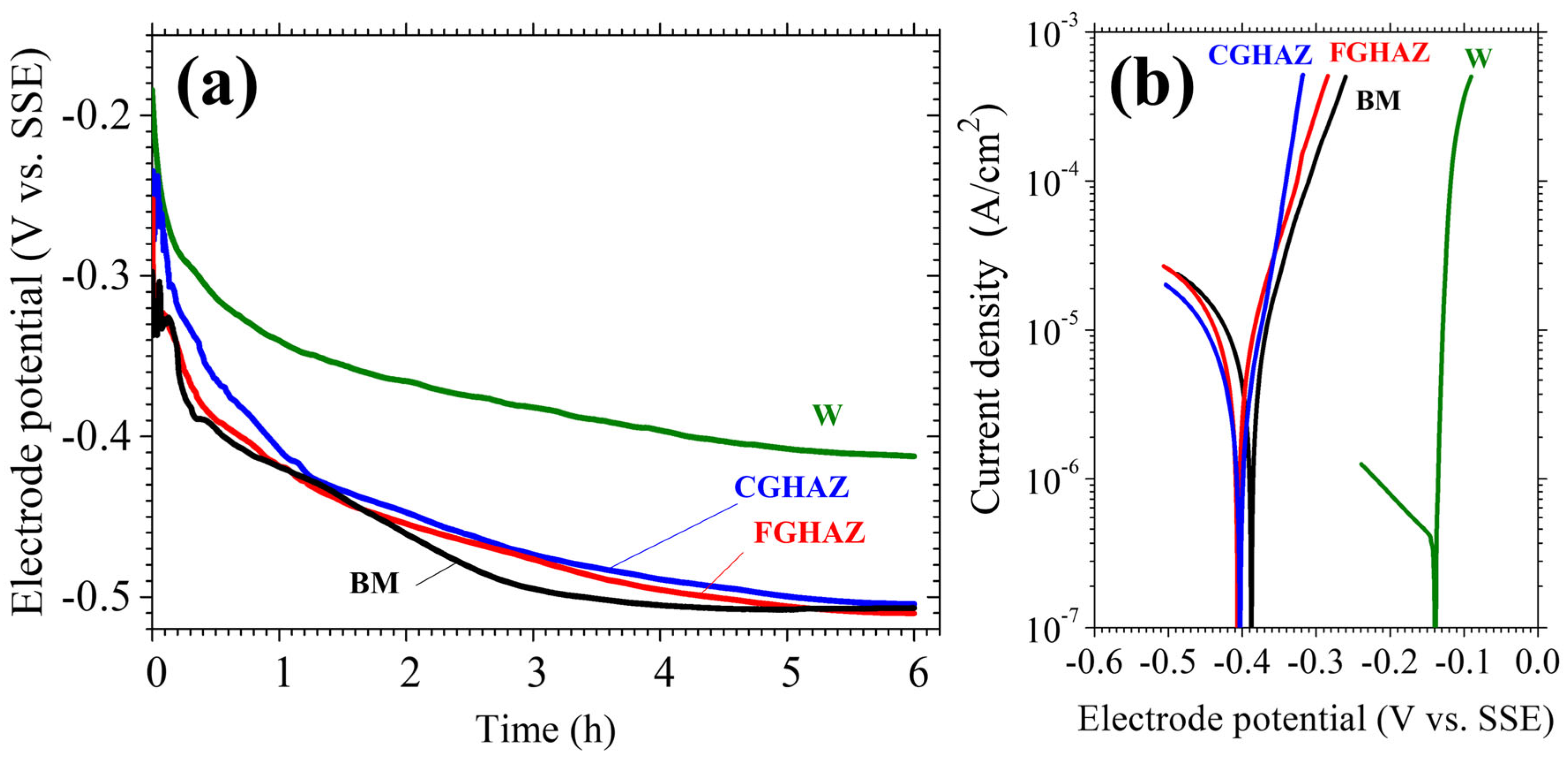
| C | Si | Mn | S | P | Fe |
|---|---|---|---|---|---|
| 0.30 | 0.35 | 0.30–1.00 | 0.040 | 0.040 | Bal. |
| Mechanical Properties | Yield Strength (MPa) | Tensile Strength (MPa) | Elongation (%) |
|---|---|---|---|
| Base metal (BM) | 348.6 | 505.9 | 41.2 |
| Welded part (W) | 384.1 | 531.6 | 18.7 |
| Microstructure | Ecorr (mV) | Icorr (A/cm2) | βa (mV) | βc (mV) | Rp (Ω·cm2) |
|---|---|---|---|---|---|
| W | −137 | 3.83 × 10−7 | 6.4 | 203 | 7034 |
| CGHAZ | −402 | 1.99 × 10−6 | 38.1 | 62.1 | 5126 |
| FGHAZ | −408 | 4.99 × 10−6 | 63.2 | 114 | 3535 |
| BM | −388 | 9.00 × 10−6 | 72.1 | 219 | 2618 |
Disclaimer/Publisher’s Note: The statements, opinions and data contained in all publications are solely those of the individual author(s) and contributor(s) and not of MDPI and/or the editor(s). MDPI and/or the editor(s) disclaim responsibility for any injury to people or property resulting from any ideas, methods, instructions or products referred to in the content. |
© 2025 by the authors. Licensee MDPI, Basel, Switzerland. This article is an open access article distributed under the terms and conditions of the Creative Commons Attribution (CC BY) license (https://creativecommons.org/licenses/by/4.0/).
Share and Cite
Song, M.J.; Lee, K.H.; Lee, J.-S.; Kim, H.; Kim, W.C.; Lee, S.Y. Evaluation of Crack Formation in Heat Pipe-Welded Joints. Materials 2025, 18, 2028. https://doi.org/10.3390/ma18092028
Song MJ, Lee KH, Lee J-S, Kim H, Kim WC, Lee SY. Evaluation of Crack Formation in Heat Pipe-Welded Joints. Materials. 2025; 18(9):2028. https://doi.org/10.3390/ma18092028
Chicago/Turabian StyleSong, Min Ji, Keun Hyung Lee, Jun-Seob Lee, Heesan Kim, Woo Cheol Kim, and Soo Yeol Lee. 2025. "Evaluation of Crack Formation in Heat Pipe-Welded Joints" Materials 18, no. 9: 2028. https://doi.org/10.3390/ma18092028
APA StyleSong, M. J., Lee, K. H., Lee, J.-S., Kim, H., Kim, W. C., & Lee, S. Y. (2025). Evaluation of Crack Formation in Heat Pipe-Welded Joints. Materials, 18(9), 2028. https://doi.org/10.3390/ma18092028







